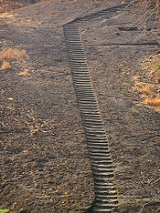
Indian rock cut architecture
Encyclopedia
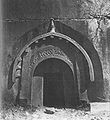
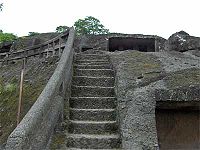


There are known more than 1,500 rock cut structures in India. Many of these structures contain artworks of global importance, most are adorned with exquisite stone carvings. These ancient and medieval structures are amazing achievements of structural engineering and craftmanship.
In India, caves have long been regarded as places of sanctity. Caves that were enlarged or entirely man-made were felt to hold the same sanctity as natural caves. In fact the sanctuary in all Indian religious structures, even free standing ones, retain the same cave-like feeling of sacredness, being small and dark without natural light.
The Oldest Caves is the Barabar caves
Barabar Caves
The Barabar Caves are the oldest surviving rock-cut caves in India, mostly dating from the Mauryan period , and some with Ashokan inscriptions, located in the Jehanabad District of Bihar, India, 24 km north of Gaya....
, Bihar
Bihar
Bihar is a state in eastern India. It is the 12th largest state in terms of geographical size at and 3rd largest by population. Almost 58% of Biharis are below the age of 25, which is the highest proportion in India....
built around 3rd Century BC, other early cave temples are found in the western Deccan, mostly Buddhist shrines and monasteries, dating between 100 BC and 170 AD. They were probably preceded as well as accompanied by wooden structures which are destroyed over time while stone endures. Throughout the history of rock-cut temples, the elements of wooden construction have been retained. Skilled craftsmen learned to mimic timber texture, grain and structure. The earliest cave temples include the Bhaja Caves
Bhaja Caves
Bhaja Caves are a group of 22 rock-cut caves dating back to 200 BC located at Karli, near Lonavala, Maharashtra. The location of Bhaja caves is not far from location of Karla Caves and these are stylistically similar to the Karla Caves...
, the Karla Caves
Karla Caves
The Karla Caves or Karle Caves are a complex of ancient Indian Buddhist rock-cut cave shrines developed over two periods – from the 2nd century BC to the 2nd century AD, and from the 5th century to the 10th century. The oldest of the cave shrines is believed to date back to 160 BC...
, the Bedse Caves
Bedse Caves
Bedse Caves are situated in Maval taluka, Pune District, Maharashtra, India.The history of the caves can be traced back up to 1st century B.C. There are two main caves. The best known cave is the chaitya with comparatively large stupa, the other cave is monastery - vihara...
, the Kanheri Caves
Kanheri Caves
The Kanheri Caves are a group of rock-cut monuments, located north of Borivali on the western outskirts of Mumbai, India, deep within the green forests of the Sanjay Gandhi National Park. It is 6 km from the National Park Main Gate & 7 km from Borivali Station. Tourists can go in after...
and some of the Ajanta Caves. Relics found in these caves suggest an important connection between the religious and the commercial, as Buddhist missionaries often accompanied traders on the busy international trading routes through India. Some of the more sumptuous cave temples, commissioned by wealthy traders, included pillars, arches, and elaborate facades during the time maritime trade boomed between the Roman Empire and south-east Asia.
Although free standing structural temples were being built by the 5th century, rock-cut cave temples continued to be built in parallel. Later rock-cut cave architecture became more sophisticated as in the Ellora Caves
Ellora Caves
Ellora is an archaeological site, from the city of Aurangabad in the Indian state of Maharashtra built by the Rashtrakuta dynasty . Well-known for its monumental caves, Ellora is a World Heritage Site. Ellora represents the epitome of Indian rock-cut architecture. The 34 "caves" – actually...
, culminating ultimately the monolithic Kailash Temple. After this, rock-cut architecture became almost totally structural in nature (although cave temples continued to be built until the 12th century), made from rocks cut into bricks and built as free standing constructions. Kailash was the last spectacular rock-cut excavated temple.
Early caves
The earliest caves employed by humans were natural caves used by local inhabitant for a variety of purposes such as shrines and shelters. The early caves included overhanging rock decorated with rock-cut artPetroglyph
Petroglyphs are pictogram and logogram images created by removing part of a rock surface by incising, picking, carving, and abrading. Outside North America, scholars often use terms such as "carving", "engraving", or other descriptions of the technique to refer to such images...
and the use of natural caves during the Mesolithic
Mesolithic
The Mesolithic is an archaeological concept used to refer to certain groups of archaeological cultures defined as falling between the Paleolithic and the Neolithic....
period (6000 BC). Their use has continued in some areas into historic times. The Rock Shelters of Bhimbetka, a World Heritage Site
World Heritage Site
A UNESCO World Heritage Site is a place that is listed by the UNESCO as of special cultural or physical significance...
, are on the edge of the Deccan Plateau
Deccan Plateau
The Deccan Plateau is a large plateau in India, making up the majority of the southern part of the country. It rises a hundred meters high in the north, rising further to more than a kilometers high in the south, forming a raised triangle nested within the familiar downward-pointing triangle of...
where deep erosion has left huge sandstone
Sandstone
Sandstone is a sedimentary rock composed mainly of sand-sized minerals or rock grains.Most sandstone is composed of quartz and/or feldspar because these are the most common minerals in the Earth's crust. Like sand, sandstone may be any colour, but the most common colours are tan, brown, yellow,...
outcrops. The many caves and grotto
Grotto
A grotto is any type of natural or artificial cave that is associated with modern, historic or prehistoric use by humans. When it is not an artificial garden feature, a grotto is often a small cave near water and often flooded or liable to flood at high tide...
s found there contain primitive tool
Tool
A tool is a device that can be used to produce an item or achieve a task, but that is not consumed in the process. Informally the word is also used to describe a procedure or process with a specific purpose. Tools that are used in particular fields or activities may have different designations such...
s and decorative rock paintings that reflect the ancient tradition of human interaction with their landscape, an interaction that continues to this day.
Cave temples
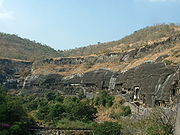
Western Ghats
The Western Ghats, Western Ghauts or the Sahyādri is a mountain range along the western side of India. It runs north to south along the western edge of the Deccan Plateau, and separates the plateau from a narrow coastal plain along the Arabian Sea. The Western Ghats block rainfall to the Deccan...
topography with its flat-topped basalt
Basalt
Basalt is a common extrusive volcanic rock. It is usually grey to black and fine-grained due to rapid cooling of lava at the surface of a planet. It may be porphyritic containing larger crystals in a fine matrix, or vesicular, or frothy scoria. Unweathered basalt is black or grey...
hills, deep ravine
Ravine
A ravine is a landform narrower than a canyon and is often the product of streamcutting erosion. Ravines are typically classified as larger in scale than gullies, although smaller than valleys. A ravine is generally a fluvial slope landform of relatively steep sides, on the order of twenty to...
s and sharp cliff
Cliff
In geography and geology, a cliff is a significant vertical, or near vertical, rock exposure. Cliffs are formed as erosion landforms due to the processes of erosion and weathering that produce them. Cliffs are common on coasts, in mountainous areas, escarpments and along rivers. Cliffs are usually...
s, was suited to their natural inclinations. The earliest of the Kanheri Caves
Kanheri Caves
The Kanheri Caves are a group of rock-cut monuments, located north of Borivali on the western outskirts of Mumbai, India, deep within the green forests of the Sanjay Gandhi National Park. It is 6 km from the National Park Main Gate & 7 km from Borivali Station. Tourists can go in after...
were excavated in the 1rst and 2nd centuries B.C. as were those at Ajanta
Ajanta
The Ajanta Caves in Aurangabad district of Maharashtra, India are 29 rock-cut cave monuments which date from the 2nd century BCE. The caves include paintings and sculptures considered to be masterpieces of both Buddhist religious art as well as frescos which are reminiscent of the Sigiriya...
which were occupied continuously by Buddhist monks from 200 BCE to 650 AD. The Buddhist ideology encouraged identification with trade, monasteries became stopovers for inland traders and provided lodging houses that were usually located near trade routes. As their mercantile and royal endowments grew, cave interiors became more elaborate with interior walls decorated with paintings and reliefs and intricate carvings. Facades were added to the exteriors as the interiors became designated for specific uses as monasteries (vihara
Vihara
Vihara is the Sanskrit and Pali term for a Buddhist monastery. It originally meant "a secluded place in which to walk", and referred to "dwellings" or "refuges" used by wandering monks during the rainy season....
s) and worship halls (chaitya
Chaitya
A chaitya is a Buddhist or Jain shrine including a stupa. In modern texts on Indian architecture, the term chaitya-griha is often used to denote assembly or prayer hall that houses a stupa.-History:...
s). Over the centuries simple caves began to resemble three-dimensional buildings, needing to be formally designed and requiring highly skilled artisans and craftsmen to complete. Theses artisans had not forgotten their timber roots and imitated the nuances of a wooden structure and the wood grain
Wood grain
In speaking of wood the term grain refers to the alternating regions of relatively darker and lighter wood resulting from the differing growth parameters occurring in different seasons . The term is used in several ways. Perhaps most important is that in woodworking techniques...
in working with stone.
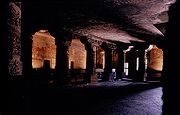
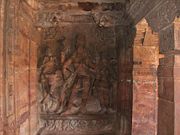
Basadi
Basadi is a Jain shrine or temple.The word is generally used in South India, including Maharashtra. Its historical use in North is preserved in the names of the Vimala Vasahi and Luna Vasahi temples of Mount Abu...
, temples and monasteries
Monastery
Monastery denotes the building, or complex of buildings, that houses a room reserved for prayer as well as the domestic quarters and workplace of monastics, whether monks or nuns, and whether living in community or alone .Monasteries may vary greatly in size – a small dwelling accommodating only...
, many with chandrashala
Chandrashala
Chandrashala is the term most often used to describe the circular or horseshoe arch that decorates so many Indian cave temples and shrines. The arch is shaped like the cross-section of a barrel vault. When used on the facade of a chaitya hall, it is called a chaitya arch...
s. The aesthetic nature of these religions inclined their followers to live in natural caves and grottos in the hillsides, away from the cities, and these became enhanced and embellished over time. Although many temples, monasteries and stupas had been destroyed, by contrast cave temples are very well preserved as they are both less visible and therefore less vulnerable to vandalism as well as made of more durable material than wood and masonry. There are around 1200 cave temples still in existence, most of which are Buddhist. The residences of monks were called Viharas and the cave shrines, called Chaitya
Chaitya
A chaitya is a Buddhist or Jain shrine including a stupa. In modern texts on Indian architecture, the term chaitya-griha is often used to denote assembly or prayer hall that houses a stupa.-History:...
s, were for congregational worship. The earliest rock-cut garbhagriha
Garbhagriha
Garbhagriha or Garbha griha is the small unlit shrine of a Hindu temple.Garbhagriha or ' is a Sanskrit word meaning the interior of the sanctum sanctorum, the innermost sanctum of a Hindu temple where resides the murti of the primary deity of the temple...
, similar to free-standing ones later, had an inner circular chamber with pillars to create a circumambulatory
Circumambulation
Circumambulation is the act of moving around a sacred object.Circumambulation of temples or deity images is an integral part of Hindu ritual. It is also practised in Buddhism. In Islam, circumambulation is performed around the Kaaba in Mecca, in a counter-clockwise direction...
path (pradakshina
Pradakshina
Pradakshina or Pradakshinam , meaning circumambulation, consists of walking around in a 'circle' as a form of worship in Hindu ceremonies in India. The devotees walk around the sanctum sanctorum, the innermost chamber of the shrine housing the temple deity. It is done around sacred fire , trees and...
) around the stupa
Stupa
A stupa is a mound-like structure containing Buddhist relics, typically the remains of Buddha, used by Buddhists as a place of worship....
and an outer rectangular hall for the congregation of the devotees.
The Ajanta Caves in Maharashtra
Maharashtra
Maharashtra is a state located in India. It is the second most populous after Uttar Pradesh and third largest state by area in India...
, a World Heritage Site, are 30 rock-cut cave Buddhist temples carved into the sheer vertical side of a gorge near a waterfall-fed pool located in the hills of the Sahyadri mountains. Like all the locations of Buddhist caves, this one is located near main trade routes and spans six centuries beginning in the 2nd or 1st century B.C. A period of intense building activity at this site occurred under the Vakataka
Vakataka
The Vākāṭakas were a royal Indian dynasty that originated from the Deccan in the mid-third century CE. Their kingdom is believed to have extended from the southern edges of Malwa and Gujarat in the north to the Tungabhadra River in the south as well as from the Arabian Sea in the western to the...
king Harisena between 460 and 478 A profuse variety of decorative sculpture, intricately carved column
Column
A column or pillar in architecture and structural engineering is a vertical structural element that transmits, through compression, the weight of the structure above to other structural elements below. For the purpose of wind or earthquake engineering, columns may be designed to resist lateral forces...
s and carved relief
Relief
Relief is a sculptural technique. The term relief is from the Latin verb levo, to raise. To create a sculpture in relief is thus to give the impression that the sculpted material has been raised above the background plane...
s are found, including exquisitely carved cornice
Cornice
Cornice molding is generally any horizontal decorative molding that crowns any building or furniture element: the cornice over a door or window, for instance, or the cornice around the edge of a pedestal. A simple cornice may be formed just with a crown molding.The function of the projecting...
s and pilaster
Pilaster
A pilaster is a slightly-projecting column built into or applied to the face of a wall. Most commonly flattened or rectangular in form, pilasters can also take a half-round form or the shape of any type of column, including tortile....
. Skilled artisans crafted living rock to imitate timbered wood (such as lintel
Lintel (architecture)
A lintel can be a load-bearing building component, a decorative architectural element, or a combined ornamented structural item. It is often found over portals, doors, and windows.-Structural uses:...
s) in construction and grain and intricate decorative carving, although such architectural elements were ornamental and not functional in the classical sense.
Another example of cave temple architecture are the Badami Cave Temples at Badami, the early Chalukya capital, carved out in the 6th century. There are four cave temples hewn from the sides of cliffs, three Hindu
Hindu
Hindu refers to an identity associated with the philosophical, religious and cultural systems that are indigenous to the Indian subcontinent. As used in the Constitution of India, the word "Hindu" is also attributed to all persons professing any Indian religion...
and one Jain, that contain carved architectural elements such as decorative pillars and brackets as well as finely carved sculpture and richly etched ceiling panels. Nearby are many small Buddhist cave shrines.
Monolithic rock-cut temples
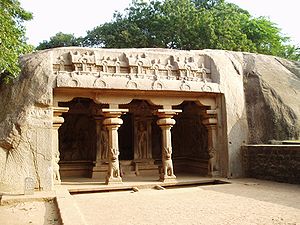


Pallava
The Pallava dynasty was a Tamil dynasty which ruled the northern Tamil Nadu region and the southern Andhra Pradesh region with their capital at Kanchipuram...
architects started the carving of rock for the creation of a monolithic copies of structural temples. A feature of the rock-cut cave temple distribution until the time of the early Pallavas is that they did not move further south than Aragandanallur, with the solitary exception of Tiruchitrapalli on the south bank of the Kaveri River
Kaveri River
The Kaveri , also spelled Cauvery in English, is a large Indian river. The origin of the river is traditionally placed at Talakaveri, Kodagu in the Western Ghats in Karnataka, flows generally south and east through Karnataka and Tamil Nadu and across the southern Deccan plateau through the...
, the traditional southern boundary between north and south. Also, good granite exposures for rock-cut structures were generally not available south of the river.
A rock cut temple is carved from a large rock and excavated and cut to imitate a wooden or masonry temple with wall decorations and works of art. Pancha Rathas
Pancha Rathas
Pancha Rathas - an example of monolith Indian rock-cut architecture dating from the late 7th century, located at Mamallapuram, a tiny village south of Madras in the state of Tamil Nadu, India.-History:...
is an example of monolith Indian rock cut architecture dating from the late 7th century located at Mamallapuram,a UNESCO World Heritage Site.
Ellora cave temple 16, the Kailash Temple, is singular in that it was excavated from the top down rather than by the usual practice of carving into the scarp of a hillside. The Kailash Temple was created through a single, huge top-down excavation 100 feet deep down into the volcanic basaltic cliff rock. It was commissioned in 8th century by King Krishna I
Krishna I
Krishna I , an uncle of Dantidurga, took charge of the growing Rashtrakuta Empire by defeating the last Badami Chalukya ruler Kirtivarman II in 757. This is known from the copper plate grant of Emperor Govinda III of 807 and a copper plate grant of the Gujarat Rashtrakuta Emperor Karka from Baroda...
and took more than 100 years to complete. The Kailash Temple, or cave 16 as it is known at Ellora Caves
Ellora Caves
Ellora is an archaeological site, from the city of Aurangabad in the Indian state of Maharashtra built by the Rashtrakuta dynasty . Well-known for its monumental caves, Ellora is a World Heritage Site. Ellora represents the epitome of Indian rock-cut architecture. The 34 "caves" – actually...
located at Maharastra on the Deccan Plateau
Deccan Plateau
The Deccan Plateau is a large plateau in India, making up the majority of the southern part of the country. It rises a hundred meters high in the north, rising further to more than a kilometers high in the south, forming a raised triangle nested within the familiar downward-pointing triangle of...
, is a huge monolith
Monolith
A monolith is a geological feature such as a mountain, consisting of a single massive stone or rock, or a single piece of rock placed as, or within, a monument...
ic temple dedicated to Lord Shiva. There are 34 caves built at this site, but the other 33 caves, Hindu, Buddhist, and Jain, were carved into the side of the plateau rock. The effect of the Kailash Temple is that of a free-standing temple surrounded by smaller cave shrines carved out of the same black rock. The Kailash Temple is carved with figures of gods and goddesses from the Hindu Puranas
Puranas
The Puranas are a genre of important Hindu, Jain and Buddhist religious texts, notably consisting of narratives of the history of the universe from creation to destruction, genealogies of kings, heroes, sages, and demigods, and descriptions of Hindu cosmology, philosophy, and geography.Puranas...
, along with mystical beings like the heavenly nymphs and musicians and figures of good fortune and fertility. Ellora Caves is also a World Heritage Site
World Heritage Site
A UNESCO World Heritage Site is a place that is listed by the UNESCO as of special cultural or physical significance...
.

Free-standing temples
There is no time line that divides the creation of rock-cut temples and free-standing temples built with cut stone as they developed in parallel. The building of free-standing structures began in 5th century, while rock cut temples continued to be excavated until the 12th century. An example of a free-standing structural temple is the Shore TempleShore Temple
The Shore Temple is so named because it overlooks the Bay of Bengal. It is a structural temple, built with blocks of granite, dating from the 8th century AD. It was built on a promontory sticking out into the Bay of Bengal at Mahabalipuram, a village south of Chennai in the state of Tamil Nadu,...
, with its slender tower, built on the shore of the Bay of Bengal
Bay of Bengal
The Bay of Bengal , the largest bay in the world, forms the northeastern part of the Indian Ocean. It resembles a triangle in shape, and is bordered mostly by the Eastern Coast of India, southern coast of Bangladesh and Sri Lanka to the west and Burma and the Andaman and Nicobar Islands to the...
with finely carved granite
Granite
Granite is a common and widely occurring type of intrusive, felsic, igneous rock. Granite usually has a medium- to coarse-grained texture. Occasionally some individual crystals are larger than the groundmass, in which case the texture is known as porphyritic. A granitic rock with a porphyritic...
rocks cut like bricks and dating from the 8th century. It is considered to be part of Group of Monuments at the Mahabalipuram UNESCO World Heritage Site
Rock-cut monuments in India
- AiholeAiholeAihole is a temple complex in the Bagalkot district of Karnataka, India. It is a very popular tourist spot in north Karnataka. It lies to the east of Pattadakal, along the Malaprabha River, while Badami is to the west of both....
has one JainaJainismJainism is an Indian religion that prescribes a path of non-violence towards all living beings. Its philosophy and practice emphasize the necessity of self-effort to move the soul towards divine consciousness and liberation. Any soul that has conquered its own inner enemies and achieved the state...
and one Brahmanical temple. - Badami Cave Temples
- Bagh CavesBagh CavesThe Bagh Caves are a group of nine rock-cut monuments, situated among the southern slopes of the Vindhyas in Kukshi tehsil of Dhar district in Madhya Pradesh state in central India. These monuments are located at a distance of 97 km from Dhar town. These are renowned for mural paintings by...
- Ellora CavesEllora CavesEllora is an archaeological site, from the city of Aurangabad in the Indian state of Maharashtra built by the Rashtrakuta dynasty . Well-known for its monumental caves, Ellora is a World Heritage Site. Ellora represents the epitome of Indian rock-cut architecture. The 34 "caves" – actually...
has twelve Buddhist, 17 HinduHinduHindu refers to an identity associated with the philosophical, religious and cultural systems that are indigenous to the Indian subcontinent. As used in the Constitution of India, the word "Hindu" is also attributed to all persons professing any Indian religion...
and five Jain temples. - Kanheri CavesKanheri CavesThe Kanheri Caves are a group of rock-cut monuments, located north of Borivali on the western outskirts of Mumbai, India, deep within the green forests of the Sanjay Gandhi National Park. It is 6 km from the National Park Main Gate & 7 km from Borivali Station. Tourists can go in after...
- Mahabalipuram
- Pancha RathasPancha RathasPancha Rathas - an example of monolith Indian rock-cut architecture dating from the late 7th century, located at Mamallapuram, a tiny village south of Madras in the state of Tamil Nadu, India.-History:...
- Pandavleni CavesPandavleni CavesPandav Leni, , are a group of 24 - 30, 1200-year-old Hinayana Buddhist caves. These were built by various Buddhist kings as homes for the saints. Most of the caves are Viharas except for the 18th cave which is a Chaitya...
- Shore TempleShore TempleThe Shore Temple is so named because it overlooks the Bay of Bengal. It is a structural temple, built with blocks of granite, dating from the 8th century AD. It was built on a promontory sticking out into the Bay of Bengal at Mahabalipuram, a village south of Chennai in the state of Tamil Nadu,...
- structural - Undavalli cavesUndavalli cavesThe Undavalli Caves , an example of Indian rock-cut architecture and a finest testimonial of ancient vishwakarma sthapathis, are located in the village of Undavalli in Tadepalli Mandal in Guntur District, near the southern bank of Krishna river, in the state of Andhra Pradesh, India.The caves are...
- Varaha Cave TempleVaraha Cave TempleVaraha Cave Temple, an example of Indian rock-cut architecture dating from the late 7th century, is a rock-cut cave temple located at Mamallapuram, is a finest testimonial of anciest Vishwakarma Sthapathis, a tiny village south of Chennai in the state of Tamil Nadu, India...
at Mamallapuram
See also
- List of rock cut temples in India
- Rock-cut architecture
- New Seven Wonders of the WorldNew Seven Wonders of the WorldNew7Wonders of the World was an initiative started in 2001 by the Swiss corporation New7Wonders Foundation to choose Wonders of the World from a selection of 200 existing monuments. A popularity poll was led by Canadian-Swiss Bernard Weber and organized by the New7Wonders Foundation based in...
- List of archaeological sites sorted by country
- List Of Colossal Sculpture In Situ
- List of megalithic sites
External links
- History of Architecture Site
- Architectural Styles
- New York Times article 'Rock-cut temple of the many faced God', August 19, 1984
- St. Olaf College Art Course Handouts
- Ellora Caves UNESCO World Heritage Site
- Lycian Influence to the IndianCave Temples
- Group of Monuments at Mahabalipuram UNESCO World Heritage Site
- Elephanta Caves UNESCO World Heritage Site
- UNESCO World Heritage: Rock Shelters of Bhimbetka
- Indian rock cut temples
- In the Holy Caves of India
- Photographs of Indian rock cut architecture and other sites
- Kailesh Rock Cut Temple
- Kerala Temple Architecture
- Pallava Art and Architecture
- Cave architecture
- The rock-cut temples of western India

